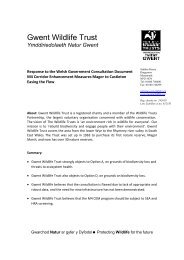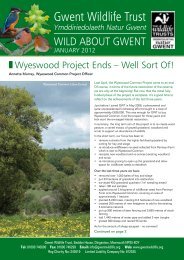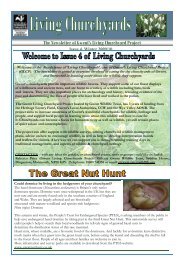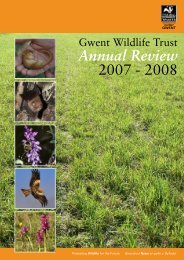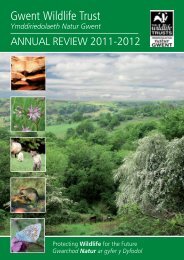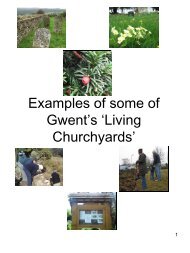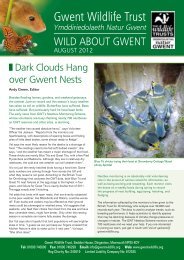Wild About Gwent April 2012.pdf - Gwent Wildlife Trust
Wild About Gwent April 2012.pdf - Gwent Wildlife Trust
Wild About Gwent April 2012.pdf - Gwent Wildlife Trust
You also want an ePaper? Increase the reach of your titles
YUMPU automatically turns print PDFs into web optimized ePapers that Google loves.
NEWS IN BRIEF<br />
Waxwing (Margaret Holland)<br />
– A Year in Review<br />
As the long autumn wore on, we began to<br />
worry about our hibernating wildlife. Our bats,<br />
dormice, hedgehogs, reptiles, and amphibians<br />
need cold weather to start hibernating, but<br />
also for it to stay cold so that they don’t wake<br />
up too soon. A very mild winter can result in<br />
disturbed hibernation, which means those<br />
animals use up their valuable reserves, looking<br />
for food that isn’t yet there. We will have<br />
to wait and see how the recent frosts have<br />
impacted on these early risers.<br />
The good news<br />
Despite the jumbled weather, 2011 wasn’t<br />
completely without successes. GWT’s<br />
conservation efforts – surveying, management,<br />
and advice – are bringing about results.<br />
Dormice were recorded for the first time<br />
in Strawberry Cottage Wood and Cuhere<br />
Wood. Water voles are returning to the north<br />
of the <strong>Gwent</strong>. Meadow thistle has returned<br />
to Cleddon Bog SSSI following restoration<br />
management. And the second site for the rare<br />
Silurian moth in Wales was also found.<br />
<strong>Gwent</strong><br />
Ecology<br />
Comprehensive, professional and<br />
pragmatic ecological services for<br />
planning, development and conservation<br />
The state of things to come<br />
So what’s in store for 2012? GWT will continue<br />
to work hard to protect and encourage wildlife<br />
in <strong>Gwent</strong> during the <strong>Wild</strong>life <strong>Trust</strong>s movement’s<br />
centenary year. It’s also a big year for policy,<br />
with expected consultations on plans and<br />
policies covering everything from delivery of<br />
nature conservation and management across<br />
Wales and Marine Protected Areas, down to<br />
local development plans at the county level.<br />
Climate change predictions state that if we<br />
are not able to limit the global temperature<br />
rise to two degrees, we will experience much<br />
more extreme, less predictable weather<br />
patterns. The weather patterns we’ve seen in<br />
2011 show how even small changes from the<br />
norm can have serious impacts on our wildlife.<br />
Although conservationists can help wildlife by<br />
creating and managing high quality, connected<br />
habitats, we can’t stop climate change by<br />
ourselves. It’s up to everyone to try.<br />
Thanks to Martin Anthoney, Jan Kinchington,<br />
Steph Tyler, and Steve Williams.<br />
<strong>Gwent</strong> Ecology • Seddon House • Monmouth • NP25 4DY<br />
T 01600 740600 • F 01600 740299 • info@gwentecology.co.uk<br />
www.gwentecology.co.uk<br />
Leucistic dunnock<br />
(John Harding BTO)<br />
What Turns<br />
a Blackbird<br />
White?<br />
A recent article from The Telegraph says<br />
ornithologists are searching for clues to<br />
a mystery condition that causes birds to<br />
have unusually coloured plumage. The<br />
discolouration, called leucism, can turn<br />
house sparrows pink, red woodpeckers<br />
yellow, and crows white.<br />
Some ornithologists believe the condition<br />
may be caused by changes in diet.<br />
Populations of house sparrows living by a<br />
Scottish salmon farm became pink after<br />
feeding on prawn shells used to give<br />
salmon more colour. Scientists believe<br />
the yellow on blue tit breasts comes from<br />
the volume of caterpillars they eat. If<br />
there are fewer caterpillars, the colour<br />
fades. And unlike albinos, whose eyes are<br />
pink, leucistic birds retain normal coloured<br />
eyes.<br />
A survey by the British <strong>Trust</strong> for<br />
Ornithology will examine the reasons for<br />
the colour variations and see how they<br />
might influence behaviour. For instance,<br />
robins with white breasts seem to more<br />
shy then those with red breasts.<br />
If you see a wild bird with some form<br />
of plumage abnormality, then please<br />
report it to the BTO Abnormal Plumage<br />
Survey – www.surveymonkey.com/s/<br />
plumagesurvey. To learn more about<br />
the Abnormal Plumage Survey, visit the<br />
British <strong>Trust</strong> for Ornithology website at<br />
www.bto.org/gbw.<br />
<strong>April</strong> 2012



